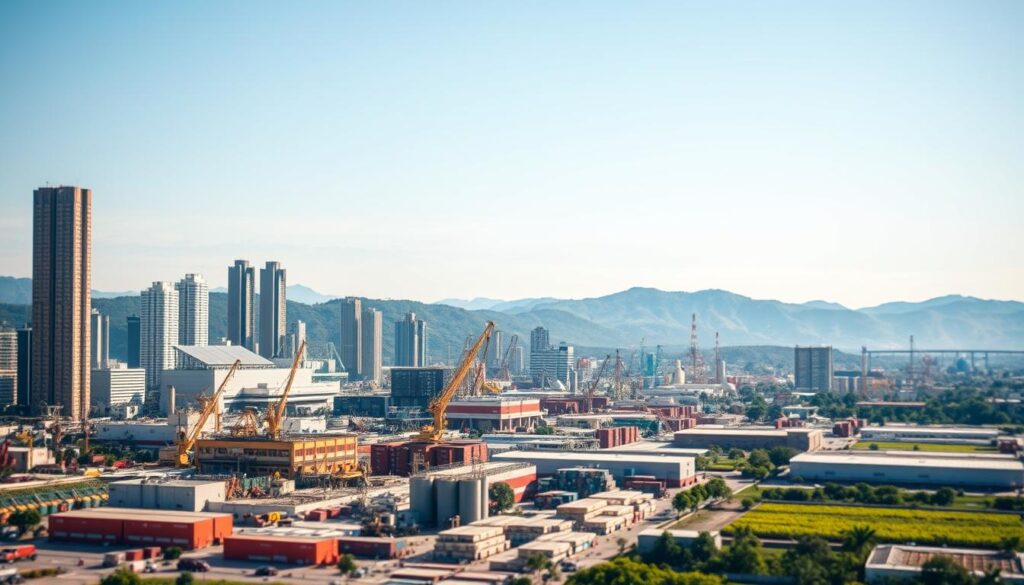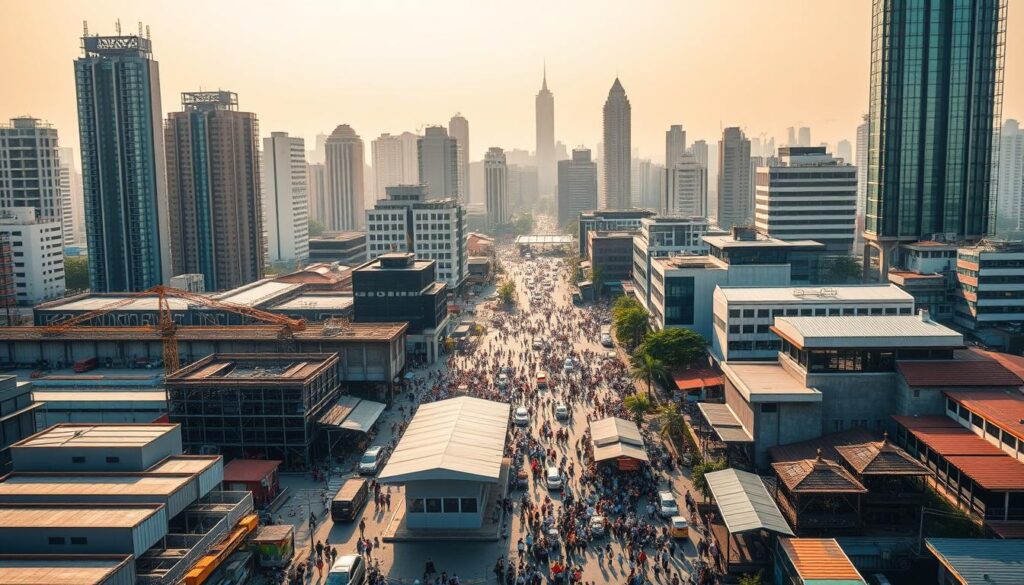The Philippines market is growing fast, making it a great time for businesses to dive in. By studying the Philippine economy analysis, companies can spot new business trends in the Philippines. Small and medium enterprises (SMEs) need to stay updated with market changes.
By 2025, the Philippines aims to become a higher-income country. This shows the country’s strength, even with inflation and changing consumer habits. We will look into market research in the Philippines, covering the economy, consumer trends, and key industries. Mastering events management in the Philippines is key to making the most of these chances.
Key Takeaways
- The Philippines is set to reach upper middle-income status by 2025.
- Understanding the Philippine economy is crucial for businesses aiming to thrive.
- Monitoring consumer behaviors is essential in a post-pandemic environment.
- Emerging trends in technology offer significant opportunities.
- Government policies are pivotal in shaping the business landscape.
Overview of the Philippine Economy
The Philippine economy is showing strong growth after the pandemic. It saw a 7.6% increase in 2022, beating government targets. This makes the Philippines a top performer in ASEAN.
This growth is thanks to strong domestic spending. This is due to better jobs and more freedom to move around.
Looking forward, the economic outlook philippines looks good. The middle class is expected to grow as incomes rise. This means more people can buy things, helping the economy keep growing.
But, there are challenges ahead. Inflation was 5.8% in 2022 and is expected to rise. This affects how much people can spend on things they want.
It’s important to understand these issues for any philippine economy analysis. This helps us see what’s happening in the market today.
| Year | GDP Growth (%) | Inflation Rate (%) | GNI per Capita (USD) |
|---|---|---|---|
| 2020 | -9.6 | 2.6 | 3,540 |
| 2021 | 5.7 | 3.9 | 3,646 |
| 2022 | 7.6 | 5.8 | 3,785 |
These points show the need for careful balance for growth. Everyone needs to watch both local and global factors in the Philippines’ economy.
Economic Growth and Performance Analysis
The Philippines’ economy has seen both highs and lows. In the first quarter of 2023, the GDP growth rate was 6.4%. This shows a slow but steady increase, despite challenges like inflation and tighter spending.
Reports show that global price hikes are affecting the market. Yet, the government is hopeful. They predict a 6-7% GDP growth for the year. This goal aims to boost investor confidence and keep the economy moving.
Understanding the economy requires looking at government plans to boost growth. Tackling these issues is key to the country’s economic strength.

Current Philippines Market Trends
The Philippines market is growing fast in many areas. E-commerce is booming, thanks to more internet use and new shopping habits. Market research shows this trend will keep growing, changing the retail scene.
Growth of E-commerce in the Philippines
E-commerce in the Philippines is expected to grow a lot. It’s set to hit ₱16.75 billion by 2025, with a 10.05% annual growth rate. By 2029, it could reach ₱24.57 billion. Businesses need to get online to keep up with this shift.
Consumer Spending Patterns Post-Pandemic
After the pandemic, how people spend money has changed. Online shopping is now more popular, thanks to better mobile access and digital payments. Companies must understand these new habits through market research to keep their customers.
Impact of Inflation on Market Dynamics
Inflation is changing how people shop in the Philippines. Higher prices mean less money to spend, changing buying habits. Businesses must adjust their prices and marketing to stay ahead in this new economic landscape.
Key Industries Driving Economic Growth
The Philippines has many industries that help its economy grow. The tech and IT-BPO sectors lead the way. Manufacturing also plays a big role in the country’s development. Knowing about these industries helps us see their impact and growth potential.
Technology and IT-BPO Sector Expansion
The tech and IT-BPO sectors are big players in the Philippine economy. The country has a skilled workforce and offers cost-effective solutions. This makes it a key spot for business process outsourcing.
As more people need digital solutions, investments in this sector keep growing. This shows a bright future ahead.
Manufacturing Growth and Opportunities
The manufacturing industry is on the rise, offering many chances. The extraction of important minerals and growth in renewable energy are getting support. Policy reforms aim to boost productivity and make the Philippines more competitive.

Understanding Consumer Behavior in the Philippines
For businesses, knowing how people shop in the Philippines is key. Today, more people want to buy online because it’s easy and cheap. Sites like Shopee and Lazada are getting more popular because they offer lots of products at good prices.
Shifts in Consumer Preferences
Now, people care more about the quality of what they buy and how easy it is to shop. Shopping online from home is a big hit because it’s convenient and has lots of choices. Businesses must make their online stores better to meet these new shopping habits.
The Rise of Digital Payment Solutions
Using digital payments has changed how we buy things. Services like GCash and Maya make paying online easy. Businesses need to make paying for things online simple to keep customers happy.
Opportunities for Businesses in the Philippine Market
The Philippine market is full of chances for businesses to grow. E-commerce is booming, making it easier for small businesses to shine. This shift is attracting more people to shop online, opening up big opportunities for those ready to adapt.
The government is also helping out with plans like the E-commerce Roadmap. This aims to improve digital services, drawing in more investors. Such efforts make it easier for entrepreneurs to start new projects in this thriving market.
The health and wellness sector is also showing great promise. With more people caring about their health, there’s a big demand for related products. The young, tech-savvy crowd is looking for quality, giving companies a chance to connect with them through smart marketing.
Getting into the Philippines can lead to many growth opportunities. By matching what customers want with what you offer, you can find lasting success in this lively market.

Challenges in Doing Business in the Philippines
The Philippines offers many business opportunities, but it also has challenges. One big issue is the lack of good infrastructure. This makes it hard to get things done efficiently.
Transportation and power issues can cause delays and extra costs. This is a big problem for businesses.
Dealing with the government can also be tough. There’s a lot of red tape that slows things down. This can make it hard to start or grow a business.
Money matters like inflation can also be unpredictable. This affects profits and planning. Businesses need to manage costs well to stay afloat.
Small and medium businesses face even more hurdles. They often struggle to get funding and access new technology. This makes it hard for them to compete.
In short, while the Philippines is a great place for business, it’s important to know the challenges. Understanding these can help businesses grow and succeed.
Government Policies and Economic Reforms
In recent years, the Philippines has made big changes in its government policies. These changes aim to make the country more welcoming to investors. The government has passed laws to make doing business easier and to let in more foreign investment.
For example, the Amendments to the Public Service Act now allow more foreign ownership in key areas like technology and infrastructure. This move is expected to attract more investments and help the economy grow.
The Corporate Recovery and Tax Incentives for Enterprises Act (CREATE) is another big step forward. It lowers corporate tax rates, helping businesses save money and invest more in themselves. This shows the government’s dedication to making Philippine industries more competitive.

Here’s a quick look at some key government policies and how they might affect the Philippine economy:
| Policy Measure | Description | Expected Impact |
|---|---|---|
| Amendments to the Public Service Act | Allows increased foreign ownership of public services | Boosts investment in key sectors |
| CREATE Act | Reduces corporate tax rates to encourage reinvestment | Provides financial relief to businesses |
| Ease of Doing Business Act | Streamlines business registration processes | Encourages new entrepreneurs |
| National Economic Recovery Plan | A comprehensive strategy addressing post-pandemic challenges | Stabilizes and revitalizes the economy |
Foreign Investment Trends and Insights
The Philippines’ foreign investment scene has seen changes due to rules and global economic shifts. New economic policies aim to boost foreign investor interest. They tackle old barriers that slowed growth.
Changes in Foreign Ownership Regulations
New laws on foreign ownership have reshaped the Philippines’ investment scene. The government has made rules more flexible, mainly in manufacturing and key services. These changes aim to attract more foreign direct investments, drawing in companies wanting to grow in the area.
Impact of Global Events on Investments
Global economic conditions play a big role in foreign investment in the Philippines. Uncertainties, market swings, and trade policy changes can either pull back or draw in investors. With the right policies and infrastructure, the Philippines could see more investment from abroad.
Conclusion
The economic outlook for the Philippines is looking good. Growth in e-commerce and technology is significant. The country’s young, tech-savvy people are driving this growth.
This makes the Philippines a key player in Southeast Asia. Our analysis shows there are many opportunities for businesses. They can take advantage of this lively market.
But, there are challenges like rules and inflation. Still, there’s a big chance for smart investments. Small and medium businesses can do well by understanding what consumers want.
They need to be flexible to stay ahead. This flexibility is key to success in a changing economy.
Businesses that keep up with the market can do well. By focusing on new ideas and meeting local needs, they can beat challenges. They can also grab the chances offered by the Philippines’ growing economy.

